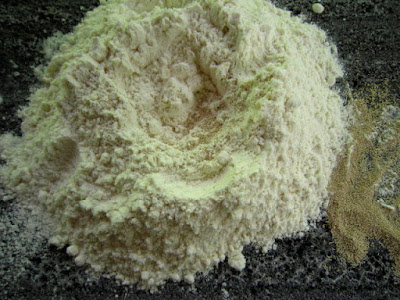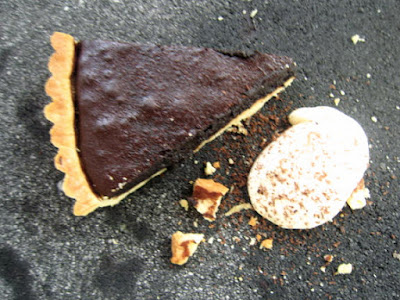Today all over Karangasem where we live, families are celebrating Odalan, the birthday of temples. On Saturday we will go pray at Pura Lumbung but today, Odalan has already started at that temple and young girls are performing Rejang Dewa (the dance for the gods), an event which takes place every year and a half. Months ago, they started to prepare for that day.
They have been dressed amd made up since early in the morning and now they are ready to wear their beautiful gelungan (hats) made out of ental (the palm leaf which is used to make lontar, the sacred books) Each one has been lovingly decorated with flowers by their mothers. Like the Banten, Gelungan is a tall and fragrant dedication to the gods, carried on the most sacred part of the body, the head.
The inherent grace and beauty of these young girls is always humbling to me, they naturally possess poise and dignity beyond their years.
Komang's beautiful little cousin, Iluh Mentik
On the other side of the village, since way before dawn, the men have been busy preparing
Cassava Leaves Stuffing for
Babi Guling, Saté and Lawar at the Banjar Dewa Mas near the temple.
Cassava Leaves Stuffing for Babi Guling
Komang's uncle (we could call him the Iron Chef of Karangasem) has been, with his two challenge ingredients "raw pork blood and bitter starfruit leaves", orchestrating the making of the mysterious Balinese Lawar.
No doubt, if you have been to Bali, you have heard about Lawar and maybe even had a chance to eat it. If not; let me explain, Lawar is mostly prepared for ceremonies and eaten as part of Megibun, the traditional shared meal. It is served as well with
babi guling. It consists of roasted and boiled pork, coconut, spices, tree leaves and raw pork blood all mixed according to each Lawar master's unique recipe. Wayan Riem, Komang's uncle, is such a master and is always asked to direct and supervise its preparation. His skills, honed through a lifetime, are unsurpassed and his Lawar is reknown to be the best in the village .
Starfruit leaves and Lombok Chilies
The making of Uncle's Riem Lawar





Wayan Riem is a very quiet man who has secrets and those are secrets he is not very inclined to share but Komang, being observant, has been able to "duplicate" his uncle's Lawar and give me a recipe that I am happy to share here. Of course, I am not
really expecting anyone to make Lawar at home but for the curious and adventurous, it might be an interesting challenge. And next time you eat it, at least you will know what's in it!
Lawar
Lawar is actually a complex dish, involving the preparation of two spice pastes, Basé Gedé and Pelalah which are mixed in three different preparations: Lawar Merah (the one with raw blood), Lawar Belimbing (with starfruit leaves) and Lawar Putih (white lawar with coconut). These three Lawar are then mixed together for the finished dish pictured below. Each of these Lawar can be served on their own.
For the Basé Gedé:
500 grs. (1lb) of shallots, peeled and finely sliced
200 grs. ( 7oz) of garlic, peeled and finely sliced
6 long red chilies, sliced
125grs ( 4.5oz) of fresh ginger, peeled and finely chopped
100grs ( 3.5oz) of fresh galangal, peeled and finely chopped
50grs (2oz) of kencur, chopped (omit if unavailable
5 candlenuts, chopped
1 Tbs roasted shrimp paste (wrap in aluminium foil and roast over a flame until pungent)
2 tsp sea salt
80 ml (3.5oz) coconut oil or bland oil
Mix all the ingredients together by hand except the oil. Add the oil in a frying pan and cook the ingedients until fragrant. Set aside.
For the Pelalah:
200grs (7oz) garlic, peeled and roughly chopped
100grs (3.5oz) kencur (omit if anavailable)
75grs (3oz) fresh turmeric, peeled and roughly chopped
5 candlenuts, chopped
2 tsp sea salt
2 tsp roasted shrimp paste
80 ml (3.5oz) bland oil
In a mortar, place all the ingredients, except the oil, and grind into a rough paste. Add the oil in a frying pan and cook the paste until fragrant. Set aside.
Lawar Merah

200grs (7oz) of pork rind, cleaned and boiled with a pinch of salt for 30 minutes
200grs (7oz) of pork meat with some fat, chopped finely and fried
100ml (3,5oz) of fresh pork blood
5 Tbs Basé Gedé
3 Tbs Pelalah
4 Tbs of shallots, peeled, sliced finely, deep-fried until golden and drained
3 or 4 bird's eye chilies, chopped finely
1 tsp roasted shrimp paste
Juice of 1 calamondin lime or regular lime
Sea salt to taste
Mix well the meats and the blood together, add the basé gedé, pelalah, chilies, shrimp paste, fried shallots and lime juice. Mix well again. Tase and adjust for salt and eventually chilies.
Lawar Belimbing
500grs ( 17oz) of Starfruit leaves, washed and boiled for 5 minutes
200grs (7oz) of pork meat with some fat, boiled 15 minutes
4 Tbs Basé Gedé
3 Tbs Pelalah
3 Tbs deep fried shallots (as described in above recipe)
3 bird's eye chilies, sliced finely
1 tsp roated shrimp paste
Juice of 1 Calamondin lime or regular lime if unavailable
Sea salt to taste
Once the starfruit leaves are boiled, rinse them under cold water and squeeze the water out, do this 3 times, it will help remove some of the bitterness.
Boil the coconut milk until thickened, about 10 minutes, cool and set aside.
Chop the meat in small pieces, set a side.
Mix the meat, coconut milk and the sarfruit leaves. Once mixed, add the basé gedé, pelalah, shallots, chilies, shrimp paste and lime and mix again. Taste and adjust the seasonings. Set aside.
Lawar Putih
1/2 fresh coconut, meat grated
150grs (5oz) of fried pork meat with some fat, chopped in small slices
150 grs (5oz) boiled pork meat with some fat, chopped in small slices
4 Tbs Basé Gedé
3 tbs Pelalah
4/5 Tbs deep-fried shallots
3 bird's eye chilies, finely sliced
Juice of 1 calamondin lime or regular lime
1 tsp roasted shrimp paste
Sea salt to taste
Mix the coconut meat and the meats. Add all the other ingredients except salt. Taste and adjust the seasonings if needed. Set aside.
For the finished Lawar, mix 1/3 of each preparation above ( Lawar merah, lawar belimbing and lawar putih) and serve with steamed rice.


























































